
|   |

|   |
Ramaavan by Surati Performing Arts - Deepsikha Chatterjee e-mail: dchatter@hunter.cuny.edu Photos courtesy: Surati Performing Arts December 9, 2023 If you are part of the Indian or South Asian diasporic community in New Jersey, chances are you have heard of Ramaavan, a musical created by Rimli Roy, Artistic Director of Surati for Performing Arts (Surati) of Jersey City. Every Fall, for at least the last ten years, Roy and Surati have produced Ramaavan in Northern Jersey, such that it is a dependable event of the area during the Indian and Hindu festive season of Navaratri/Durga Puja (nine days dedicated to Goddess prayers and festival) and Diwali, the festival of lights. Even though I had known about this piece for a while, and heard about it from friends and acquaintances in the social circle, 2023 is the first year I got to see the production in New York. This year the work was presented in NJ one weekend and in NYC the following week (Oct 25-Oct 29), with seven performances at each venue. Upon watching it, as a member of the Indian diasporic community, I feel it is important to acknowledge the deep cultural, artistic, religious, and entertainment labor Roy and Surati have put in for the community and beyond in creating this work. Since seeing it I have recommended an excerpt of it for the local NJ schools and libraries because it is important to share this work far and wide. Children will love the entertaining bits of this production, while the story has the potential to resonate with adults. The piece is designed for audiences of all ages depicting a story of "duty, honor, love, courage, justice and revenge", with Sumit Roy's original music and Rimli Roy's choreography adding much onstage charm to this original and well-known story. 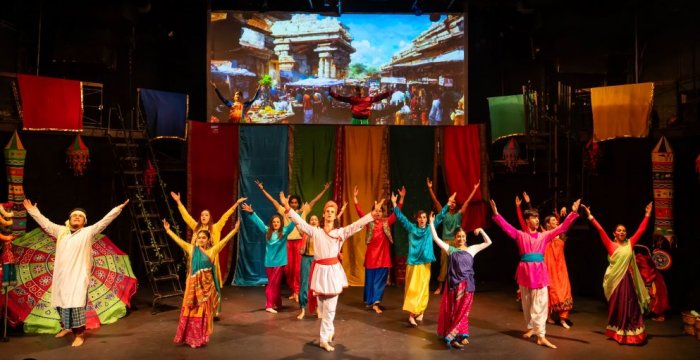 Ayodhya marketplace Ramaavan is a combination of the word Ram, the Hindu god, and Ravan, the ten-headed demon he vanquished, establishing good over evil, and rescuing his wife Sita, with support from his brother Lakshman and his associates of the monkey king Hanuman and the monkey soldiers. Ramaavan begins with an ode to the original Ramayan ascribed to Valmiki, and generously, astutely, and artistically illustrates the seven episodes of Ramayan. This is a massive task, and only Roy and Surati with deep community connections can dream of attempting an artistic--and educational--project as big as Ramayan. It begins with a colorful and happy montage of song and dance in the Ayodhya marketplace with vendors and customers celebrating the praiseworthy rule-of-law under king Dasharath and the prince Ram, played by Jonathan Gregory Power. Simple yet well-decorated props bring much color and bustle to this market scene. Yet this happy moment is short-lived as we learn that Dasharath has to send Ram away to the forest because he is beholden to a promise he made to his second queen Kaikeyi. At this point, we are introduced to the dedicated Sita, performed by Alondra Schuck and Lakshman, portrayed by Andrew Leonforte, both of whom sacrifice their lives in the palace and move to the forest with Ram. 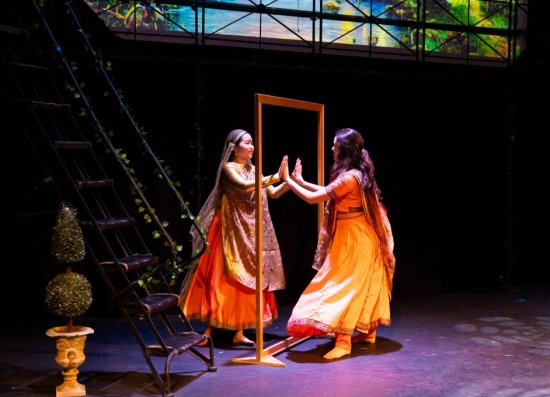 Sita reflecting on herself through a mirror The NYC production at the Cullum Theatre had projections upstage that transported the audience from the rich palace to a simple and idyllic forest. Here, dance, both in modern style by Roberto Facchin, Henry Frontini, Giordano Cruz, Annie Renita, Carly Sesti, Kijana Lewis, and US Praveen and classical Odissi style of nritta (pure movement) by Odissi-trained dancers Sriradha Paul, Jeevika Bhat, Sanika Pophale, and Tanvi Chadak, added ample doses of vigorous energy or blissful romance in the pastoral world, as necessary for the narrative. First, we saw what we had encountered in the first episode of Ayodhya, where the large cast dances with grace and paints a picture of the environment. Alongside we notice another successful technique of Roy as a storyteller - that of repetition and multiplication. This technique was used for Sita and her inner thoughts. Later it was used through the mirror image of Surpanakha (Ravana's sister who first tried to woo Ram and subsequently Lakshman and then was rejected by both, and was defaced by Lakshman) sophistically portrayed by Melissa Lubars and repeated by Ha Young Synn (Heidi). Subsequently the technique was used to show the ten soldiers of Ravana's palace, who project mass, as well as the ten heads of Ravana, they collectively amplified and strengthened the piece. The attractive golden deer--acrobatically portrayed by Facchin--entices Sita and this leads to Sita's kidnapping. Slight figured Jeevika Bhat as Jatayu, the bird who tried to rescue Sita, was paled by the tall and visually significant dancer Akshat Jha as Ravan. Following this, a small episode depicting the sky travel of Ravan and Sita flanked by several birds was presented by a lithe dance ensemble in shiny cape-wings. Masks and large pleated arm-length silk capes beautifully highlighted their flight and commanded visual presence on stage. 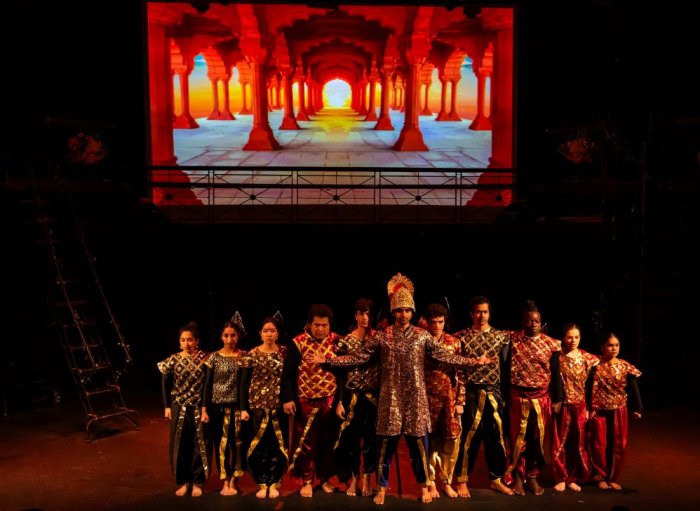 The ten headed Ravan and his crew The strengths of Ramaavan really comes through once we reach Lanka. The abstracted world depicted through rich orange and black colors in projections and in costume including semi-classical black and orange clad dancers augmenting the world, Lanka shone bright in the musical. The percussion accompaniment from Elhadji Aliyoune Faye further enhanced the movement and storytelling of Ramaavan. By this time the acrobatic Facchin had arrived as Hanuman, and with facial makeup, and circus-inspired leaps and jumps against background projections, to depict how Hanuman and the monkey soldiers played a key role in this struggle across the ocean. Once again, repetition came in handy, as three dancers signified an army with Facchin leading the way with ample agility and an appropriate dose of humor. An Odissi style welcome dance for Rama and Sita's return preluded the final episode, after Sita's rescue, when the three return to Ayodhya accompanied by Hanuman and the monkey army. This section is well crafted with a large group presented through classical dance. Even though it is a short piece at the end of a two and a half hour show, they portray the return to the capital city filled with large welcoming crowds. Through the subtlety of dance and the calmness of multiple handheld tea lights against Lauren Lee's stage lighting, the dancers filled the stage with anticipation for a welcome and a Diwali celebration. 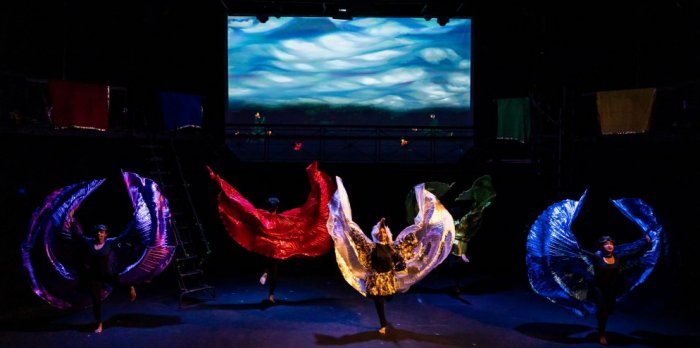 Birds across the sky Roy and Surati's Ramaavan is a mixed-genre dance, musical, and theatre piece for the people and by the people. Roy is great at being part of the community, making space for everyone through Surati's various events, and seeking help from everyone she knows in the community, with volunteers willing to put in time to keep this production going. As we know, arts organizations run by people of color have a harder time staying relevant and staying afloat in the US. Yet the fact that Roy has managed to do this year after year only proves how much she is loved for her commitment to the community, whether it is through events such as Surati's colorful Holi, or through this piece Ramaavan, and through educational events at schools, and through deep engagement with members of and within the community. My one hope for the future of this well-crafted piece is that it stays anchored to one tradition with more fidelity, rather than vacillate too much across genres. From Baul to Odissi of India to European Opera (skillfully rendered by Melissa Lubars), at times the piece feels it is trying to cover too much ground or please too wide a range of audiences. Perhaps Roy can focus more on the strengths of this piece - the use of repetition in dance characters and their movement, the classical style of Odissi, and touches of modern dance that all together work well with Sumit Roy's music. If genres of Baul and Opera are indeed used, perhaps it's best to repeat them in a few places so they don't feel like afterthoughts. And Faye's percussion can be further highlighted to magnify the excellent footwork the performers use throughout. The abstracted parts of Ramaavan are very impactful and a pleasure to watch, something Roy could lean into with deeper conviction. I urge all NYC and tristate South Asian and dance loving audiences to catch it in the Fall. 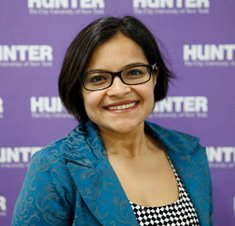 Deepsikha Chatterjee teaches theatre and design at Hunter College CUNY. She is a practicing costume designer with several awards to her name. She received her undergraduate degrees in India before moving to the US for her MFA in Costume Design from FSU. Very recently she finished her Ph.D. on masked dances of South Asia from CUNY Graduate Center. She researches costumes, masks, and performance design from South Asia and publishes on these topics. She produces and presents dance from India in New York for Indo American Arts Council. |